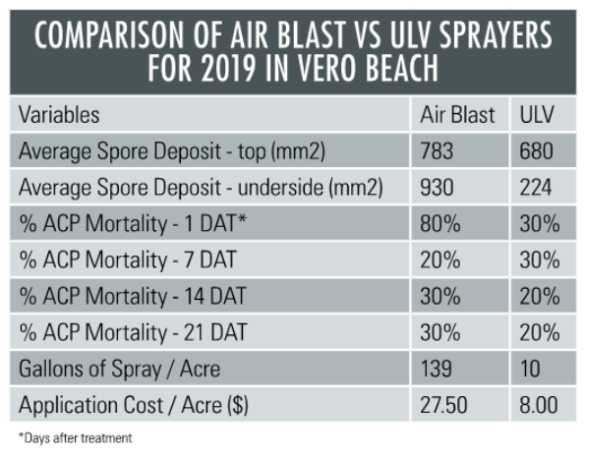
Fungal biopesticide results utilizing air blast sprayers and ultra-low-volume sprayers were comparable, but air blast applications were less costly.
While the use of biocontrol products has been gaining more attention in recent years as new products come online, it’s certainly not a new practice. Dr. Pasco Avery, a Biological Scientist with the UF/IFAS Indian River Research and Education Center, discovered in the State Plant Board of Florida Bulletin that Florida growers used fungal biopesticides to manage arthropod pests as early as 1916.
From 1907 to 1911, Professor H.S. Fawcet cultured an entomopathogenic “insect eating” fungus (EPF) with pieces of sterilized sweet potatoes in wide-mouth bottles. Fawcet aimed to use the fungus as a biopesticide against insect pests that he knew were attacking commercial citrus trees. He worked at the Florida Experiment Station in Lake Alfred, now known as the Citrus Research and Education Center.
“In 1916, during the peak of the citrus production season, a whitefly infestation threatened Florida citrus trees,” Avery says. “In response to this problem, Fawcet prepared 358 fungal cultures, and officials with the Florida Entomological Department distributed the cultures to growers. The growers then sprayed their trees with the fungal culture suspension, and 50% reported excellent results.”
After 1916, state officials planned to mass-produce the fungus so that more growers could use the organism as a deterrent in the following fruit production years. However, the intended mass-production for developing a fungal biopesticide did not take place; but instead, widespread applications of chemical insecticides were used to control pest arthropods.
EPF OPTION
According to Avery, in 1986, Lance Osborne at the UF/IFAS Mid-Florida Research and Education Center in Apopka isolated an EPF from a mealybug that was identified as a strain of Cordyceps (= Isaria) fumosorosea.
Eventually, a fungal product that contains spores of the C. fumosorosea Apopka strain was formulated as PFR-97 20% WDG in 1990. This product could be used for control of whiteflies, aphids, thrips, and spider mites, but only on non-food commodities.
In the mid-2000s, Jason Meyer, a graduate student at UF, discovered an Asian citrus psyllid infected with an EPF in a Polk County citrus grove. This EPF was later identified as another C. fumosorosea strain.
In 2011, Avery, along with international scientists, helped to get PFR-97 re-registered as a pesticide residue tolerance exempt product with the EPA. This formulation of PFR-97 is now commercially available to growers. It can be utilized in an IPM program for psyllid control and various arthropod pests in citrus, including the Diaprepes root weevil, brown citrus aphid, and citrus leafminer.
TESTING EFFICACY
Avery, in collaboration with Robert and Matthew Adair of The Florida Research Center for Agriculture Sustainability, ran trials of the product at the Center’s groves in Vero Beach.
In May 2018, PFR-97 was applied to fruit-bearing citrus trees by using a Rears Air Blast sprayer and was compared to Delegate as a grower standard. Both products were also mixed with petroleum oil (JMS Stylet Oil). And, JMS Stylet Oil was applied alone. An uncontrolled check was also in the trial.
Psyllid adults were counted by using the tap method. All products significantly suppressed the psyllid populations at 14 days after treatment compared to the untreated control trees. In addition, it was observed that PFR-97 was compatible with beneficial insects, including lady beetles, lacewings, and the parasitoid Tamarixia radiata, that were present at the study site. These results show that PFR-97 is as effective in suppressing psyllid populations and can be used in rotation as part of a citrus IPM spray program that will delay or avoid pest resistance to synthetic chemical insecticides.
An additional test compared application types — air blast versus ultra-low volume — of PFR-97 and JMS Stylet Oil. “Spore deposition and leaf coverage on the top side of the leaf were satisfactory with both sprayers,” Avery notes (see table). “However, the air blast sprayer was more effective in coverage on the underside of the leaf. Overall, either application technology is effective for applying the fungal biopesticide, but the cost using the air blast sprayer may be cheaper.”
HEAT AND HUMIDITY ARE KEY
The research also showed that a temperature of 75˚F or above is important for the fungal biopesticide’s performance against the psyllid. It also is important to spray when relative humidity is greater than 75%, such as after rainfall or at dusk.
If spraying occurs at or after dusk, this will allow for the six to eight hours of high humidity needed for the spores to germinate on the citrus leaf surface. In addition, prior studies have shown that copper-based fungicides as well as adjuvants like JMS Stylet Oil are compatible with I. fumosorosea spores.
“Based on field studies, PFR-97 should not be applied as a dormant spray because the heat and humidity may not be adequate for the best performance,” Avery says. “But, by using compatible agrochemicals in combination with fungal biopesticides like PFR-97 in a spray program, this IPM strategy will help promote the EPF already present in the grove to persist and potentially increase. Overall, the use of PFR-97 as a fungal biopesticide, in combination with natural enemies of the psyllid and other beneficial arthropods already present or released in the grove, can help growers develop a more effective and sustainable management strategy in their citrus IPM agro-ecosystem.”










